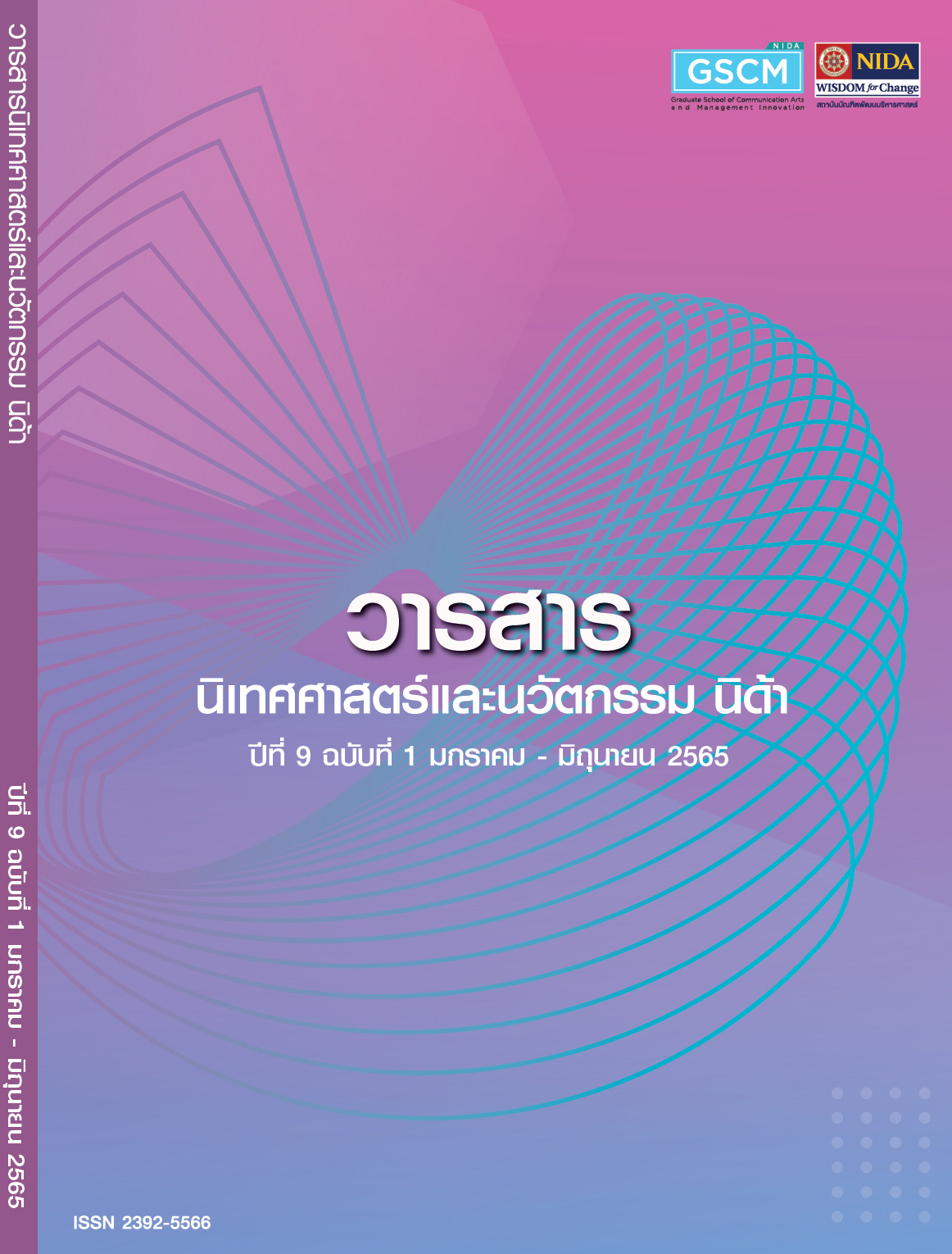The Community Participation of Production Management of Children Mask Play (Khonsod) in Kruwikchimplee Troupe for the purpose of Commercial in Performing Arts Development
Main Article Content
Abstract
The purpose of this research is to investigate problems and to manage the production of children's mask play (Khonsod) in Kruwikchimplee Troupe commercially and to establish the children's mask play training center advancing the performing arts. This research is qualitative research using participative research process, collected data and related research reports, participant and non-participant observation, in-depth. At the end, return to the interview, group discussion, organizing a community forum, lesson learned session, and integrated information to the community. The results showed that regarding the problem of organizing the Children's Mask Play (Khonsod) in the Kruwikchimplee troupe it was found that there was no clear organizational structure. The show's equipment it was old and damaged. The show lacked advertising, public relations, and marketing. Moreover, the identity of the show was unclear. There was a shortage of funds to manage the show. The show experienced there is a shortage of child actors, and the head of the show is an old man who is unwell. Actors lacked training and lack of support from public and private organizations. Moreover, the standard of performance is still incomparable with other shows. In terms of guidelines and development of the children's mask play (Khonsod) in Kruwikchimplee Commercially, it was found that the operation was carried out by the principle of the 8 Ps. (1) "Policy." (2) "Personnels” emphasized youth showing in order to develop children's mask play (Khonsod). The structure was divided according to functions. (3) "Production tooling" focused on repairing equipment to look newer. (4) "Process" was developed by performing a before/during/after evaluation, (5) "Product" focused on live Khon performances, Yokrob episodes, and children's performers. (6) A "place" for contact should be established. in order to increase online distribution channels. (7) "Promotion and marketing" focused on creating existence. through online and offline channels. (8) " Profit" was concerned with cost control, income satisfaction, and profit in the long run form of happiness. Regarding the establishment of the children's mask play training center, it was found that there was a collaboration with various network partners, including the government, private sector, and civil society. The Memorandum of Understanding (MOU) was signed in order to establish the children's mask play training The center at Wat Chorakhe Yai School, has eleven network partners.
Article Details

This work is licensed under a Creative Commons Attribution-NonCommercial-NoDerivatives 4.0 International License.
ข้อความและความเห็นในวารสารนิเทศศาสตร์และนวัตกรรม นิด้า เป็นของผู้เขียนแต่ละท่าน มิใช่ของคณะนิเทศศาสตร์และนวัตกรรมการจัดการ สถาบันบัณฑิตพัฒนบริหารศาสตร์
References
วิมลศรี อุปรมัย. (2553). นาฏกรรมและการละคร. สํานักพิมพ์จุฬาลงกรณ์มหาวิทยาลัย.
พีรพงศ์ เสนไสย. (2562). นาฏยพาณิชย์. (พิมพ์ครังที่ 2). รัตนชัย ก็อปปี้ เซ็นเตอร์ อาคารบริการกลาง (พลาซ่า) มหาวิทยาลัยมหาสารคาม.
เรณู โกศินานนท์. (2545). การแสดงพื้นบ้านในประเทศไทย. กรุงเทพฯ : บริษัทโรงพิมพ์ไทยวัฒนาพานิช จํากัด.
สุรพล วิรุฬรักษ์. (2547). หลักการแสดงนาฏยศิลป์ ปริทรรศน์. กรุงเทพฯ : สํานักพิมพ์แห่งจุฬาลงกรณ์มหาวิทยาลัย.
สุวรรณี อุดมผล. (2528). วรรณกรรมการแสดงของไทย. กรุงเทพฯ: สํานักพิมพ์ประกายพรึก.
ภาษิต จิตรภาษา. (2548). ภาษาใหม่ ความเป็นมาของ "คํา" และ "ความหมาย". กรุงเทพฯ : มติชน.
ปารวีร์ ผาลี. (2556). โขนสดคณะประยุทธ ดาวใต้ (รายงานผลการวิจัย). จุฬาลงกรณ์มหาวิทยาลัย.
จริยาวัฒน์ โลหะพูนตระกูล. (2552). การอนุรักษ์และสืบทอดโขนสดเด็ก (ศิลปะแบบลูกผสม) กับแนวคิดในการต่อต้านยาเสพติด โดยครูวิก ฉิมพลี แห่งเมืองปากนํา. วารสารศิลปศาสตร์ปริทัศน์ มหาวิทยาลัยหัวเฉียวเฉลิมพระเกียรติ, 4(8), 97-103.
กรินทร์ กรินทสุทธิ์. (2558). ปัจจัยต่อการเปลี่ยนแปลง พัฒนาการ และความหลากหลายของโขน (ทศวรรษที่ 2480 ถึงปัจจุบัน) [ปริญญานิพนธ์ปรัชญาดุษฎีบัณฑิต, มหาวิทยาลัยธรรมศาสตร์].https://ci.tu.ac.th/uploads/ci/academic-work/phd-thesis/phd-thesis-10.pdf
หทัย รัตนอุบล. (2552). การดํารงอยู่ของโขนสด : กรณีศึกษาคณะสุวิทย์ฉิมพลี ตําบลศีรษะจรเข้ใหญ่ กิ่งอําเภอบางเสาธงจังหวัดสมุทรปราการ [การศึกษาค้นคว้าอิสระศิลปศาสตรมหาบัณฑิตไม่ได้ ตีพิมพ์]. มหาวิทยาลัยเกษตรศาสตร์, กรุงเทพฯ.
เฉลิมชัย ภิรมย์รักษ์. (2545). โขนสดคณะสังวาลเจริญยิ่ง [วิทยานิพนธ์ปริญญาศิลปศาสตรมหาบัณฑิต, จุฬาลงกรณ์มหาวิทยาลัย]. Chulalongkorn University Intellectual Repository (CUIR). http://cuir.car.chula.ac.th/handle/123456789/10899
ชวพันธุ์ เพชรไกร. (2559). โขนสดคณะประยุทธ ดาวใต้ : การสืบทอดและการสร้างสรรค์เรื่องรามเกียรติ์ในสังคมไทยร่วมสมัย [วิทยานิพนธ์อักษรศาสตรมหาบัณฑิต, จุฬาลงกรณ์มหาวิทยาลัย]. Chulalongkorn University Intellectual Repository (CUIR). http://cuir.car.chula.ac.th/handle/123456789/55122
พัชรินทร์ ร่มโพธิ์ชื่น. (2557). การจัดการศิลปะการแสดงโขนของครูชูชีพ ขุนอาจ [วิทยานิพนธ์ศิลปศาสตรมหาบัณฑิต, มหาวิทยาลัยศิลปากร].http://www.thapra.lib.su.ac.th/thesis/showthesis_th.asp?id=0000011252
ฐิติวรรณ มหาวิจิตร. (2552). โครงการศูนย์ฝึกและพัฒนาศิลปะการแสดง [วิทยานิพนธ์นิเทศศาสตรมหาบัณฑิต, มหาวิทยาลัยกรุงเทพ]. http://dspace.bu.ac.th/jspui/bitstream/123456789/607/1/titiwan_maha.pdf
ตลาดหลักทรัพย์แห่งประเทศไทย ห้องเรียนผู้ประกอบการ. (ม.ป.ป.). Business Model Canvas. https://www.set.or.th/set/enterprise/html.do?name=bmc
ฤทธิรงค์ จิวากานนท์. (2549). การบริหารจัดการแสดง [เอกสารที่ไม่ได้ตีพิมพ์]. สาขาวิชาการจัดการทางวัฒนธรรม หลักสูตรศิลปศาสตรมหาบัณฑิต, จุฬาลงกรณ์มหาวิทยาลัย.
Koch, T., & Kralik, D. (2006). Participatory Action Research in Health Care. Blackwell.
Phuangsomjit. (2014). Participatory Action Research on Research in Educational Administration. (Book 2 (Unit 6-10); 3rd edition). Sukhothai Thammathirat.


